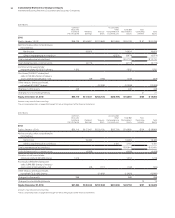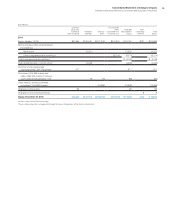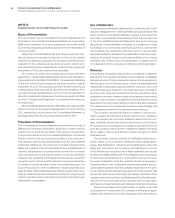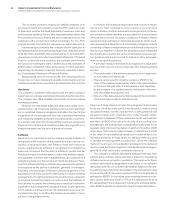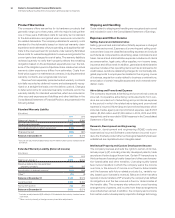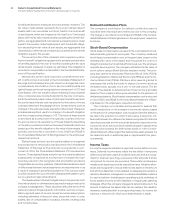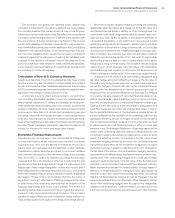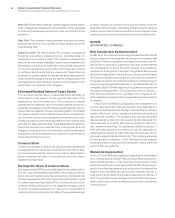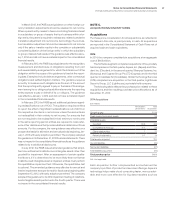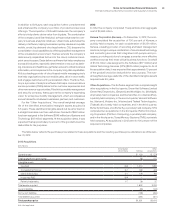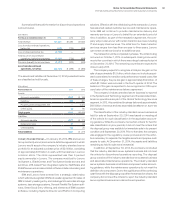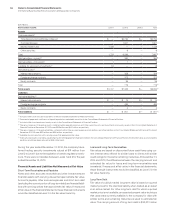IBM 2014 Annual Report Download - page 95
Download and view the complete annual report
Please find page 95 of the 2014 IBM annual report below. You can navigate through the pages in the report by either clicking on the pages listed below, or by using the keyword search tool below to find specific information within the annual report.Notes to Consolidated Financial Statements
International Business Machines Corporation and Subsidiary Companies
94
and expense. When a cash flow hedging relationship is discon-
tinued, the net gain or loss in AOCI must generally remain in AOCI
until the item that was hedged affects earnings. However, when
it is probable that a forecasted transaction will not occur by the
end of the originally specified time period or within an additional
two-month period thereafter, the net gain or loss in AOCI must be
reclassified into earnings immediately. The company reports cash
flows arising from derivative financial instruments designated as
fair value or cash flow hedges consistent with the classification of
cash flows from the underlying hedged items that these deriva-
tives are hedging. Accordingly, the cash flows associated with
derivatives designated as fair value or cash flow hedges are clas-
sified in cash flows from operating activities in the Consolidated
Statement of Cash Flows. Cash flows from derivatives designated
as net investment hedges and derivatives that do not qualify as
hedges are reported in cash flows from investing activities in the
Consolidated Statement of Cash Flows. For currency swaps des-
ignated as hedges of foreign currency denominated debt (included
in the company’s debt risk management program as addressed in
noteD, “Financial Instruments,” on pages 105 through 109), cash
flows directly associated with the settlement of the principal ele-
ment of these swaps are reported in payments to settle debt in
cash flows from financing activities in the Consolidated Statement
of Cash Flows.
Financial Instruments
In determining the fair value of its financial instruments, the com-
pany uses a variety of methods and assumptions that are based
on market conditions and risks existing at each balance sheet
date. See noteD, “Financial Instruments,” on pages 104 to 105
for further information. All methods of assessing fair value result
in a general approximation of value, and such value may never
actually be realized.
Fair Value Measurement
Accounting guidance defines fair value as the price that would be
received to sell an asset or paid to transfer a liability in an orderly
transaction between market participants at the measurement date.
Under this guidance, the company is required to classify certain
assets and liabilities based on the following fair value hierarchy:
• Level 1—Quoted prices (unadjusted) in active markets
for identical assets or liabilities that can be accessed at the
measurement date;
• Level 2—Inputs other than quoted prices included within
Level 1 that are observable for the asset or liability, either
directly or indirectly; and
• Level 3—Unobservable inputs for the asset or liability.
The guidance requires the use of observable market data if such
data is available without undue cost and effort.
When available, the company uses unadjusted quoted market
prices in active markets to measure the fair value and classifies
such items within Level1. If quoted market prices are not avail-
able, fair value is based upon internally developed models that use
current market-based or independently sourced market param-
eters such as interest rates and currency rates. Items valued using
internally generated models are classified according to the lowest
level input or value driver that is significant to the valuation.
The determination of fair value considers various factors includ-
ing interest rate yield curves and time value underlying the financial
instruments. For derivatives and debt securities, the company uses
a discounted cash flow analysis using discount rates commensu-
rate with the duration of the instrument.
In determining the fair value of financial instruments, the com-
pany considers certain market valuation adjustments to the “base
valuations” calculated using the methodologies described below
for several parameters that market participants would consider in
determining fair value:
• Counterparty credit risk adjustments are applied to financial
instruments, taking into account the actual credit risk of a
counterparty as observed in the credit default swap market
to determine the true fair value of such an instrument.
• Credit risk adjustments are applied to reflect the company’s
own credit risk when valuing all liabilities measured at fair
value. The methodology is consistent with that applied in
developing counterparty credit risk adjustments, but incor-
porates the company’s own credit risk as observed in the
credit default swap market.
As an example, the fair value of derivatives is derived utilizing a
discounted cash flow model that uses observable market inputs
such as known notional value amounts, yield curves, spot and
forward exchange rates as well as discount rates. These inputs
relate to liquid, heavily traded currencies with active markets which
are available for the full term of the derivative.
Certain financial assets are measured at fair value on a non-
recurring basis. These assets include equity method investments
that are recognized at fair value at the measurement date to the
extent that they are deemed to be other-than-temporarily impaired.
Certain assets that are measured at fair value on a recurring basis
can be subject to nonrecurring fair value measurements. These
assets include available-for-sale equity investments that are
deemed to be other-than-temporarily impaired. In the event of an
other-than-temporary impairment of a financial instrument, fair
value is measured using a model described above.
Accounting guidance permits the measurement of eligible
financial assets, financial liabilities and firm commitments at fair
value, on an instrument-by-instrument basis, that are otherwise not
permitted to be accounted for at fair value under other account-
ing standards. This election is irrevocable. The company has not
applied the fair value option to any eligible assets or liabilities.
Cash Equivalents
All highly liquid investments with maturities of three months or
less at the date of purchase are considered to be cash equivalents.


